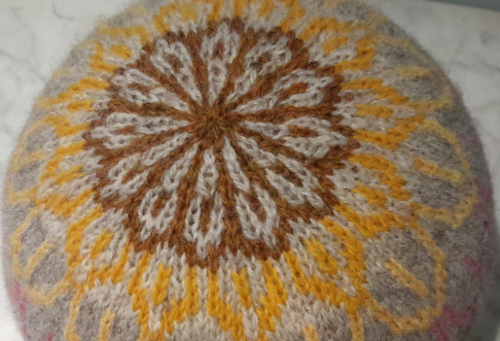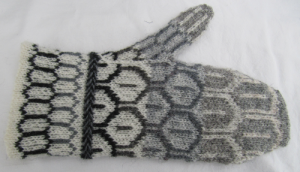If you are a knitter or crocheter, you will no doubt have heard about the controversial new design of the Ravelry website. For many dedicated and enthusiastic users of Ravelry, the site has become unusable, and so in solidarity with the crafters who are unable to buy patterns from Ravelry any longer, I am making my patterns available as downloadable PDFs in the Payhip Granary Knits Shop.
Sock Yarn Mittens
My second free pattern, designed to help you use up oddments from stash, is for full mittens with gussetted thumb and an interesting ribbed cuff. This pattern was part of my Love Your Stash Challenge for 2019, in which I aimed to use yarn from stash for a series of simple accessories.
It is knit from the finger tip to the cuff, incorporating the pre-knitted thumb as you go, and uses any standard sock yarn.
You will need:
Any standard sock yarn (I used Regia for the sample , but West Yorkshire Spinners Signature Sock would also be a good choice). If you only have small quantities of multiple different sock yarns, use them up by randomly striping, or use different colours for the thumbs, cuff, or finger tips.
Your choice of circular needles or dpns (or AddiCraSyTrio Sock needles!) in the following sizes:
2.00 mm [UK/Canada size 10, US size 3]
2.25 mm [UK/Canada size 11, US size 2.5]
Stitch markers
Tapestry needle for weaving in ends
Waste yarn
The PDF version of the free pattern can be downloaded from the Payhip Granary Knits Pattern Store. Have a look through your stash, gather your tools together, and happy knitting!

Wild Geese Hap
Did you know that a group of geese on the ground is known as a gaggle, but in the air, flying in V-formation, it is known as a skein? I love the idea of geese and yarn being connected in this way.

Wild geese fly over our house every Autumn, sometimes just one or two, sometimes in huge skeins of a hundred or more birds. They gather around our local reservoirs, ready to move off to their winter pastures. Their flight and call has long been a source of inspiration to me, and feeds into my sense of place in this landscape of dry stone walls, small streams and becks, hills and reservoirs.
The Wild Geese Hap is my response to this Autumnal landscape. Its texture denotes the skeins of geese in flight, becoming gradually larger as the hap grows, divided by ridges forming the dry stone walls, and ending with the ripples on the surface of the reservoirs, in the colours of the Canada Goose. The hap can be finished with either a plain cast off, or a knit-on edging in a triangular lacy design which looks uncannily like the wing of a goose in flight.

The pattern for Wild Geese Hap is available from the Payhip Granary Knits Pattern Store. It features two sizes, a 2m square hap or a 1m square lapghan. It is knit in scrumptious aran/worsted weight yarn in lovely natural colours, and in the round from the centre out. I used Daughter of a Shepherd Ram Jam and Castlemilk Moorit DK (which knits up as aran weight) yarns for both the hap and the lapghan. I love the sheepiness of the DoaS yarns, their wonderful bloom when they have been washed and dried, the natural colours of sheep, and the sheer warmth of the finished item.

Both sizes of the Wild Geese Hap are worked from charts, from the centre out. The blanket size is shown above with the lace border; the lapghan, shown below, has been finished with a very stretchy simple cast off, which accentuates the rippled edging and the points at the corners.

Snake’s Heid
The sinuous pattern and lacy “head” for this hat was developed during my City and Guilds Handknit textiles course, and originally formed part of a table runner. But the image of the snake’s head would not lie still, and eventually I had to turn it into a wearable accessory.

The result is a cosy beanie/toque style hat, which can be knit in fingering/4ply, DK, or aran/worsted weight yarns, in a large range of sizes. I knit the samples in 3 different blends of wonderful Blacker yarns – Lyonesse 4ply, Tamar DK, and North Ronaldsay Aran.


The pattern for Snake’s Heid can be purchased from the Payhip Granary Knits Pattern Store.
Votic Hat
Today sees the publication of my latest design, the Votic Hat. I have been very fortunate in having a preview of the lovely new yarn from Blacker Yarns, Cornish Garden, launched on 20th September 2019 as their 14th birthday yarn.
This is a beautiful soft woolly yarn in a gorgeous range of colours, and I have been delighted to provide a pattern knit in this yarn.

The design is based on a fragment of knitted material found during an archaeological dig in Estonia. The fragment dates from the 13th century and is believed to be from the cuff of a mitten. I have taken part of the motif shown in the fragment and created an unusual broken striped hat, which knits up perfectly in the 3ply/light fingering weight of Cornish Garden.

Thank you to Sue Blacker for giving me the opportunity to design with this lovely yarn.
The Votic hat pattern can be found in the Payhip Granary Knits Pattern Store.
Feather Cowl pattern published
Feather Cowl complements the Feather Cap Beanie and Feather Mittens patterns previously published. It is worked in the round, in stranded colourwork, using ten colours of Jamieson’s of Shetland wonderful pure wool Spindrift yarn. The motif itself and the colours I have chosen reflect the feather patterns and colours of my flock of hens.
The pattern can be purchased from the Payhip Granary Knits Pattern store, either as the single pattern, or as part of the Chicken Knitting e-book containing all four patterns.
Diagoniella Cowl Pattern Now Published
The textured design for this pattern sprang from my research into the fossils found at the Burgess Shale fossil site in Canada, a wealth of amazing plants and creatures which lived in the pre-Cambrian seas over 500 million years ago. Diagoniella was a protosponge, tubular in shape but with an intriguing diagonal skeletal structure which just cried out to be turned into knitting!

This cowl is designed to suit everyone. The textured pattern is understated but detailed enough to be interesting, and the deep moss ribbing ensures that cold winds are kept firmly away from the neck. It can easily be turned into a deeper cowl/snood by adding more vertical repeats of the pattern; it is written for knitting in the round. It was designed for someone who cannot tolerate wool next to the skin, and the yarn suggestions are both cotton blends that give excellent stitch definition. The cowl/snood can be knit in any DK weight yarn which has good stitch definition.
Instructions are given for three sizes, a short cowl 25 cm (approx. 10”) tall; a medium cowl 40 cm (approx. 15 ½”); and a snood 55 cm (approx. 21 ¾”).
The pattern is available in the Granary Knits Pattern Store.
Fisherman’s Rib Hat Pattern Published
Fisherman’s Rib is a lovely squishy stitch which produces a warm and very stretchy fabric. It is ideal for hats as the stretchiness makes it a perfect fit for any sized head.
I knit my version in a lovely variegated organic Merino Aran weight yarn, from Felt Fusion on Etsy, but it looks equally lovely in plain coloured, tonal, or even self striping yarn.
You can buy the pattern in the Granary Knits Pattern store.
Chicken Knitting Ebook
Of all animals, I think I have always like birds the best, probably influenced by my Mother, who kept Zebra Finches, Canaries, and Lovebirds, and avidly watched the wild birds in her garden. She even had a Silkie cockerel, rescued from a school egg-hatching program and given the run of the house and garden for many years. It was not until 2007 that I kept any birds of my own, and I started with hens. I liked the idea of fresh eggs for breakfast, but the day we acquired Hetty, Betty, and Letty, was the day I lost my heart to them. As soon as I held one in my arms, I was smitten, and the longer I have kept them, and the better I understand them, the more I see their individual characters, their behavioural traits, their likes and dislikes, their amazing colouring, the variation of comb and wattle shapes, their unique song.
When I started designing knitted textiles, my flock of hens (and one cockerel) featured very prominently in my inspiration. This first collection of patterns is a result of that inspiration, and covers the stranded colourwork designs based upon feather shapes and colours.
The patterns in the ebook collection are:

Each pattern is available individually at the Payhip Granary Knits Pattern Store.
Full Feather Mittens Pattern Released
Designed to match the Feather Cap Beanie, and the Fingerless Feather Mittens released a few weeks ago, these full mittens reflect the patterns and colours of my little flock of beautiful Cream Legbar hens (and one cockerel).
Full Feather Mitts are stranded knit mittens, using ten colours of Jamieson’s of Shetland wonderful pure wool Spindrift yarn. The motif itself and the colours I have chosen reflect the feather patterns and colours of my lovely Cream Legbar chickens: Freddie, Sorrel, Sage, and Lavender. From a distance they look a like a dull brown, but close up, their feathers are a beautiful brown/grey, with touches of cream and pink. The four background colours and six foreground colours reflect this lovely effect.
Suggestions are made for other colourways, notably a lovely monochrome palette.
The pattern is available from the Granary Knits Pattern Store.

























